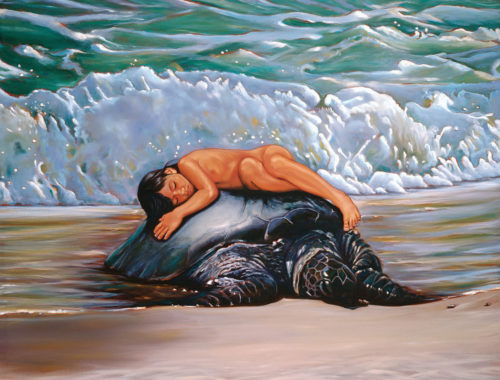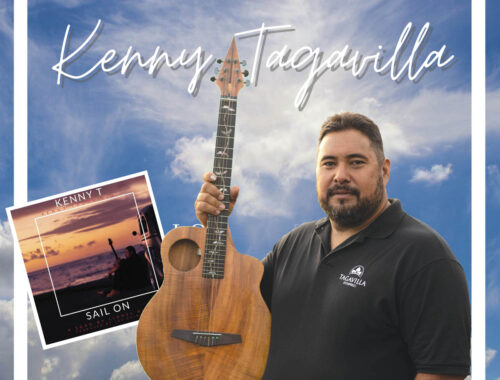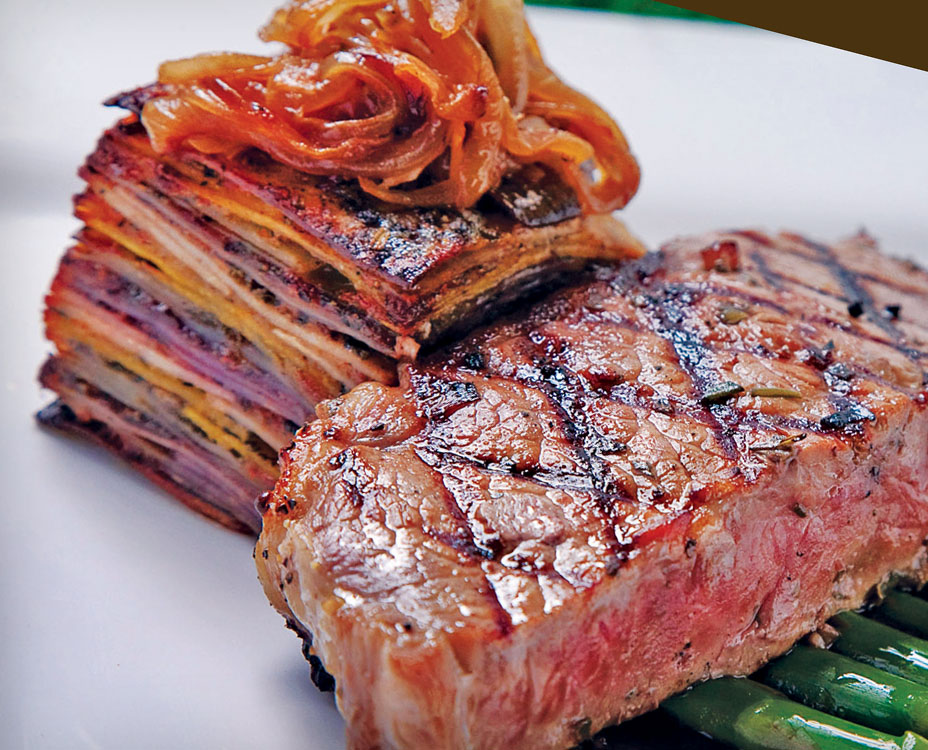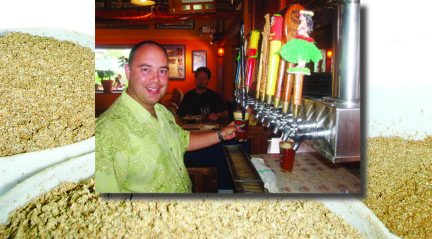
How do You Make Liquid Aloha?
By Fern Gavelek

In a 3,500-square-foot brew house, carefully measure barley malt and blend with hot Hawaiian water to form a “mash.” Heat mixture until grain converts into a fermenting sugar liquid called “wort.” Separate the “spent” grain from the wort for later use as cattle feed.
Next, bring the wort to a rolling boil and add the hops for flavor and aroma. Stir and reduce temperature to 68 degrees. Add yeast and let set about a week (longer for lagers) while tasting daily for quality control. Chill beer to 36 degrees and store a few weeks until flavor matures. Enjoy responsibly!
Got that?
Brewing beer is all in a day’s work for Brewmaster Rich Tucciarone at Kona Brewing Company (KBC). He is in the business of concocting “liquid aloha”—the stable of handcrafted beers produced at KBC. Part chef and part chemist, he meanders among towering stainless steel vats full of brew at the company’s Kailua-Kona facility. He taps samples to analyze taste and uses a density-sensitive hydrometer to track the fermentation process.

“To ensure the beer’s alcoholic content we measure density, as alcohol is less dense than water,” explains Tucciarone, who came to KBC in 1999 after working at Breckenridge Brewery & Pub in Denver. The New York native learned the brewmaster trade while attending Chicago’s Siebel Institute of Technology and holds a degree in food science with a focus on fermentation and product development from Cornell University.
Kona Brewing Company expects to produce two million cases of its handcrafted liquid aloha in 2009. With brewing operations in Kona; Portland, Oregon; and Portsmouth, New Hampshire; a fourth goes on line in March in Woodinville, Washington. Based on 2007 sales figures, KBC is one of the nation’s top 25 breweries and its beer is distributed in approximately 22 U.S. states and Japan.
“Simply speaking, making beer is taking the grain and steeping it like a tea bag,” says KBC President and CEO Mattson Davis. “The grain creates food for the yeast and the by-products are alcohol and CO2.”
More Controls, Conditions & Idiosyncrasies Than Wine Making

Davis adds that beer making involves more controls, conditions and idiosyncrasies than wine making. “It’s about the precise combination of grain, water, hops and yeast.”
Kona Brewing Company gets grain—barley—from the upper U.S. or southern Canada with the help of four maltsters. A maltster works with farmers to secure barley and oversees its malting process. Malting involves the controlled germination of barley and the use of heat to stop this natural process.
According to Tucciarone, barley is “steeped, dried and roasted into different types of malts,” which give beer its flavorful body and color. This is done through a complex kilning process and to customer specification. “Barley gets roasted, dark or light, by controlling temperature, moisture and time,” he details. Different malts are used for creating different beers, such as KBC’s copper-colored Fire Rock Pale Ale or dark Black Sand Porter.
Hops, which are female flower cones of the hop plant, come to KBC from Washington; there are different varieties of hops and they are responsible for the bitterness and aroma of the finished beer. Their characteristics are described as “floral”, “spicy” or “citrus.”
Yeast is the driver in beer brewing. The yeast used in beer is different from the kind used to make bread. Davis says KBC uses a “pure strain of yeast” sourced from a yeast lab. There are top-fermenting, ale yeasts and bottom-fermenting, lager yeasts. Along with the crop ingredients, yeast plays an important role in the type of beer created and its taste.
In addition to the main ingredients, KBC uses tropical products to create its assortment of a dozen styles of beer.
“Our limited-release program is tropical and unique,” says Davis, who came to KBC in 1997 from Portland with a background in restaurant operations and sales. The program got underway in 2005, had its first release in the fall of 2006, and in 2007 Pipeline Porter won a bronze medal at the Great American Beer Festival.
Pipeline Porter, available as a limited release in the fall and winter, showcases the flavor of 100-percent Kona coffee, mixing coffee beans right into the malt. Heralding Kona’s most famous food product, it is released at the onset of the annual coffee harvest. It is marketed as “smooth and dark with a distinctive, roasty aroma and earthy complexity from its diverse blends of premium-malted barley. Freshly roasted, 100-percent Kona coffee and a delicate blend of hops rounds out this palate-pleasing brew.”
The limited-edition beers were specifically formulated for enjoyment during different seasons. Pipeline Porter is geared for the winter with its hardy, full-bodied flavor and heavy dark color. Wailua Wheat, on the other hand, is light, refreshing and a thirst quencher. It goes down easy and you can have two or three servings without feeling too full. Sold in the spring and summer, it is brewed with passionfruit for a fresh, citrusy aroma and crisp, tart finish.
In addition to creating new beers at KBC, Tucciarone often must modify KBC’s original recipes for its three flagship brews: Fire Rock Pale Ale, Longboard Island Lager and Big Wave Golden Ale. The tweaks to the recipes adjust to the nuances of ingredients used. For example, weather may alter the quality or flavor of grain or hops, but KBC must still make a consistent-tasting beer every time.
“Rich is an expert at this,” notes Davis. “He understands how to manage grain intensity and the alpha acid content of the hops to produce the desired result.”
The brewmaster and his Kailua-Kona staff of nine also dabble in brewing oak-barrel-aged beer—a specialty item served periodically at KBC’s Kona Brewpub. Described as “a labor of love,” these small-batch beers are served in snifters for “fun experimentation and variety.”
Beer has a 110-day shelf life, so distribution goes into full swing after beer is deemed finished by the brew staff. The freshest way to get KBC’s beer is in a growler, a half-gallon glass jug filled directly from KBC’s taps in Kona, or at KBC’s restaurants in Kona or at Koko Marina in Hawai‘i Kai on O‘ahu.
Minimizing Carbon Footprint
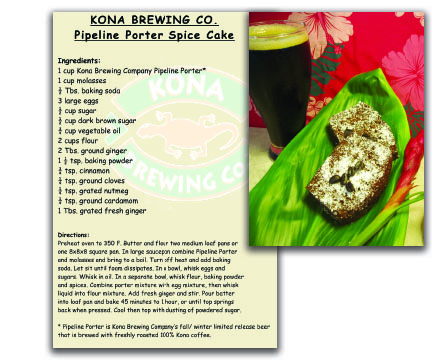
“We believe in delivering the freshest, high-quality beer to our consumers and so we are expanding to distribute close to them,” emphasizes Davis, who reports 70 percent of KBC’s market is the Mainland. “By doing so, we also minimize our carbon footprint.”
According to Davis, KBC’s strategy is to feed markets by working with partners who can deliver KBC beer most effectively. He says KBC leases Mainland brew houses to make its beer, including a hydro-powered brewery in Portland that is nine times bigger than the Kona brew house. “It saves a ton of money and resources.”
In 1998, KBC stopped packaging its Kona-brewed beer in bottles because it became too expensive. “We were shipping empty bottles to the Big Island so they could be filled and shipped back out again,” recalls Davis. “It was a carbon nightmare.”
Environmental, social and fiscal responsibility—the triple bottom line—has always been a KBC value under Davis’ leadership. He has instituted a sustainable business model that is big on “reduce, reuse and recycle.”
The company has a long list of green initiatives that include using biodegradable carry-out containers and napkins, as well as recycling 80 tons of plastic, metal, paper and glass annually. A major green improvement to the KBC Kona brew house is the addition of two large grain silos to eliminate having to dispose of 13,000 non-recyclable bags annually.
Through a host of energy-saving methods, KBC has cut its energy consumption by 10 percent—even though it produces a temperature-sensitive commodity. Rather than air condition the entire brew house, vats and tanks are individually refrigerated using insulated jackets containing a chilled, liquid gel.
While KBC strives to lessen its environmental impact, it aims to make a noticeable difference in the local community. In 2008, the company donated nearly $20,000 in product and merchandise to benefit local schools, non-profit organizations and county agencies.“
We consciously practice ‘Business to Business’ in our community when seeking goods and services,” adds Davis. He says KBC is in the “low 80 percent” for the total amount of Hawai‘i-produced food products used in its restaurants. “My goal is to take it to the mid-90s. It all comes down to committing to farmers that you’re going to buy their products.”
Annual Kona Brewer’s Festival
KBC’s annual Kona Brewer’s Festival, 2:30-6:30 p.m. March 14, promotes craft brewing and recycling. The festival taps up on the grounds of King Kamehameha’s Kona Beach Hotel and has raised $313,000 for Big Isle beneficiaries. It is in its 14th year.
“We’re members of the Kona community and I want our community to be successful,” says Davis, who is married with two young sons. “We need to do what it takes to promote that success.”
It’s no surprise that the next time you’re at a local fundraiser, you’ll be served a hand-crafted beer from Kona Brewing Company. After all, there’s nothing better than toasting good will with a fresh and cold glass of “liquid aloha.” ❖
